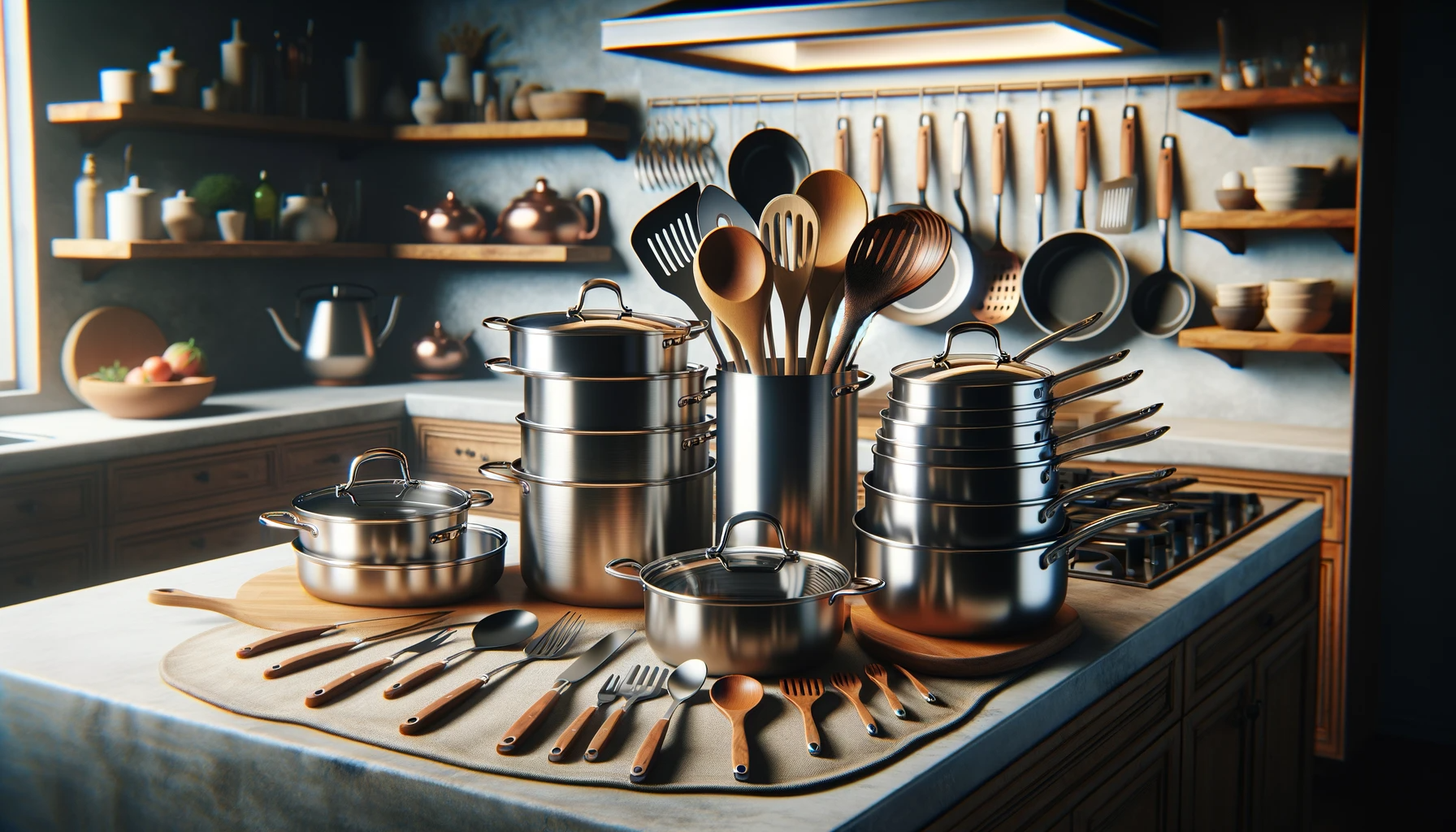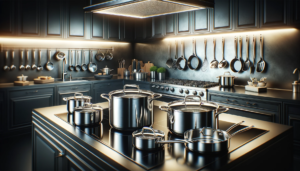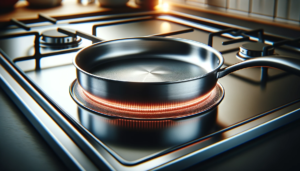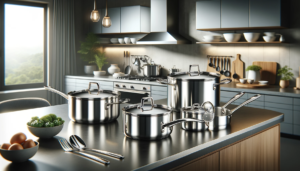Have you ever noticed scratches or discoloration forming in your stainless steel pots and wondered if metal utensils are slowly damaging them?
Metal utensils can degrade stainless steel cookware over many years of use by causing surface scratches that enable corrosion, warping, and rust spots.
Let’s examine why metal utensils pose risks to stainless steel pots and pans, safer alternative utensil options, and how to use metal tools more carefully if avoiding replacement.
Can I Use Metal Utensils on Stainless Steel Cookware?

You can use metal utensils on stainless steel cookware, but it risks damaging the surface over many years of prolonged use.
Metal utensils like spoons and spatulas are harder than stainless steel pans.
So through repeated stirring motions and contact over time, metals gradually scratch the cookware surface leading to corrosion and rust spots.
To prevent metal utensil damage, it’s best to instead use wood, plastic, silicone or bamboo utensils which are softer and won’t scratch pans.
Read more here.
If still opting for metals, take care when cooking by avoiding scrubs, replacing old worn utensils and addressing minor scratches early.
While stainless steel is durable, metal utensil risks remain needing awareness.
What Are Metal Utensils and Stainless Steel Cookware?
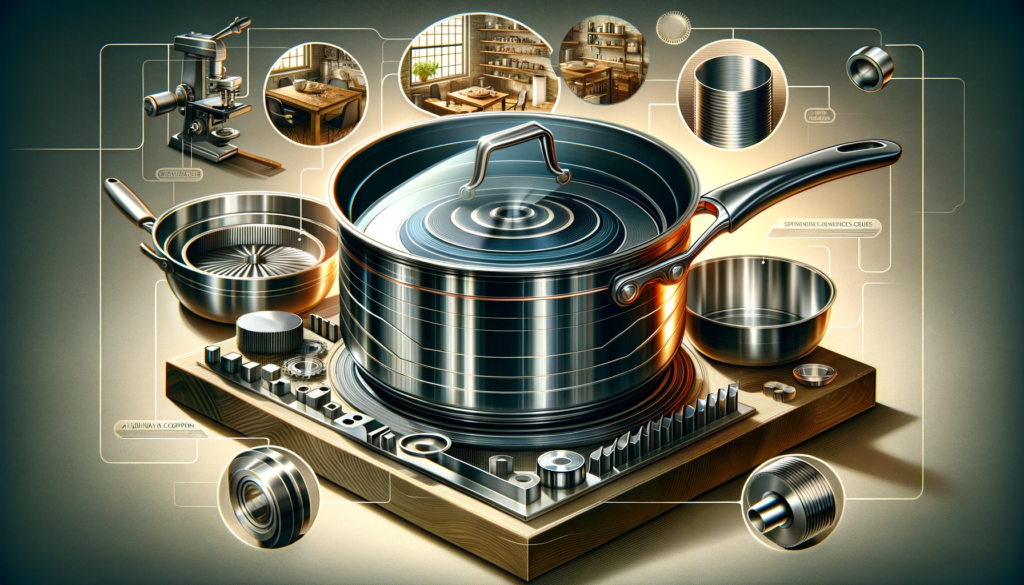
Metal utensils refer to spoons, forks, knives, spatulas, tongs, ladles and other cooking tools that are made from metallic materials such as stainless steel, silver, copper or aluminum.
Of these, stainless steel is one of the most popular metals used to construct utensils because of its strength, corrosion resistance and affordability.
Stainless steel utensils offer the beneficial properties of being durable, rigid, and long-lasting tools that stand up well to regular cooking duty without bending or wearing out too quickly.
Their hardness makes them well suited for tasks like stirring thick mixtures, turning meat cuts, or flipping pancakes where soft flexible utensils may fail.
However, stainless steel’s hardness does pose the downside that over many years of use, some gradual scratching or surface damaging of cooking vessels can occur.
Stainless steel cookware refers to pots, pans, skillets, baking sheets, steamer baskets and other cooking vessels that are constructed using stainless steel metal.
In cookware, stainless steel is an ideal material thanks to its sturdy construction, stain and rust resistance, ease of cleaning, longevity and corrosion resistance.
Stainless steel pans do not react with acidic foods during cooking which helps maintain pure flavors.
The main benefit of stainless steel over some other metals is that the chromium content (usually 18% or more) in stainless steel forms an invisible passive layer of chromium oxide on the cookware surface that protects against rusting or iron leaching even under high heat.
Optimal cooking performance relies on quality stainless steel cookware made with thick gauges and clad bottoms to allow even, consistent heating.
Using Metal Utensils Can Damage Stainless Steel Over Time

While stainless steel cookware is designed to resist staining, pitting and corrosion, it can still gradually become damaged from the prolonged daily use of metal cooking utensils over many years.
Metal spoon and spatula edges are usually harder than the stainless steel used to construct cookware.
This means that during routine cooking tasks like stirring sauces, turning potatoes, scraping pans, flipping eggs, and more, microscopic scratches in the cookware surface slowly develop.
At first, these extremely fine scratches are invisible.
But over more months and years of continuous metal utensil usage scrapping the surface, the tiny scratches compound until eventually becoming visible larger scratches, pits and deeper grooves etched into the stainless steel cookware interior.
Larger scratches from metal utensils are problematic because food particles get trapped and baked inside of them during cooking.
These food deposits then chemically interact with the exposed stainless steel metal, which breaks down the top layer of chromium oxide that normally protects the stainless steel underneath from interacting with oxygen.
Once the passive layer disappears due to scratches, rust corrosion spots begin developing on cookware over time.
The iron leaching out from rusting also destroys the nonstick performance.
Warped stainless steel along scratch grooves on pan bottoms also negatively impacts heating conductivity.
Damaged cookware means ingredients start burning, boiling over or cooking unevenly.
Vigorously scrubbing stainless steel pans with abrasive scouring pads also accelerates metal damage like scratches over time.
The intense friction wears down the protective surface.
Wire pads or metal utensil edges used in circular motions under pressure scrubs away stainless layers leading to deformation issues like warping or wavy pan bottoms.
Avoiding harsh scrubbing reduces damage.
Read more at: https://enlivewire.com/stainless-steel-cookware/does-stainless-steel-cookware-scratch/
Use non-abrasive pads gently in straight back and forth motions instead.
Immediately replace deeply scratched pans to avoid worsening performance issues.
Alternative Utensils are a Better Choice
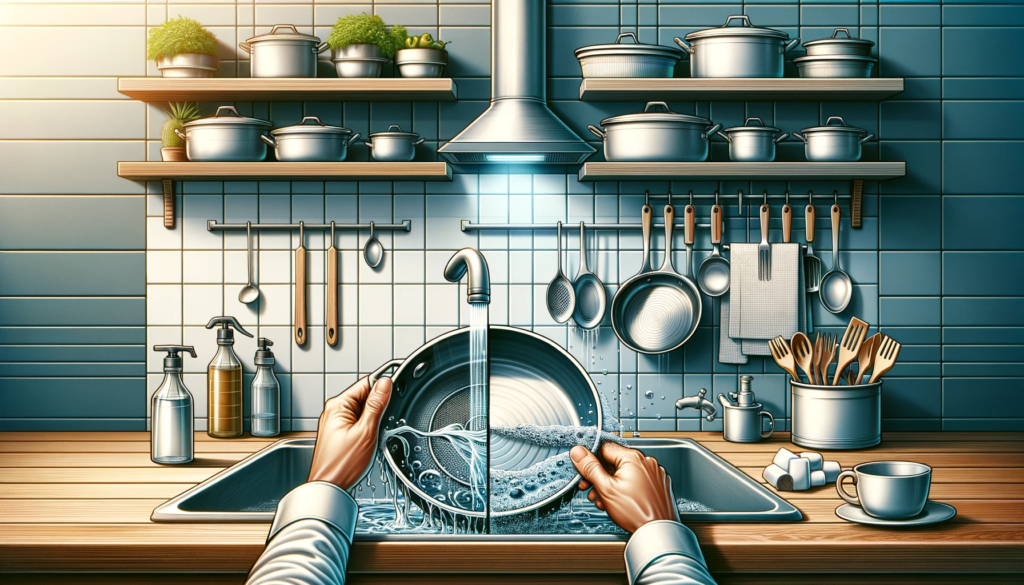
Due to the gradual risk of metal utensils damaging stainless steel cookware through accumulated surface scratches over continuous use spanning several years, many chefs and cooking experts advise using alternative utensil materials whenever possible instead.
Plastic, wood, bamboo, silicone, nylon, rubber and composite options are all better choices than metals for protecting stainless steel pans.
Not only are these materials usually softer than cookware surfaces, avoiding permanent scratches, but they also ensure gentle treatment of expensive nonstick finishes which metal can strip off over time.
The best alternative utensil options are those that deliver adequate strength and rigidity to comfortably handle all necessary cooking tasks, while still being soft enough that their surfaces erode with usage rather than permanently damaging pans.
Silicone, wood, and plastic utensils won’t leave behind scratches in the stainless steel cookware surface where food debris gets trapped.
This prevents corrosion issues over many years helping stainless steel pots maintain peak performance.
Alternative utensils also offer comfortable, secure gripping for kitchen safety.
Using gentler plastic, wood, bamboo or silicone utensils are all effective precautions to take for preventing gradual scratches in regular stainless steel pans or ceramic coating degradation on more delicate nonstick surfaces.
Doing so preserves optimal longevity of all expensive cookware for many years before replacements become necessary.
Bamboo Utensils
Bamboo is an eco-friendly, renewable hardwood material being used more frequently to construct high quality cooking utensils and serveware.
Bamboo is valued for its smooth polished appearance and natural bacteria fighting properties from fast growing manageable forests, unlike slower growing tree woods.
Bamboo cooking utensils offer affordable options that won’t scratch pans when used properly.
The hardy material stands up well to boiling, high heat exposure, and vigorous usage without splintering or cracking under pressure.
Thanks to bamboo’s tight wood grain and naturally occurring silica, it resists absorbing stains, odors and flavors relatively easily between uses after proper cleaning and drying.
Applying mineral oil periodically protects bamboo, while storage racks keep utensils separated for optimal air circulation.
Bamboo cooking tools like spoons, spatulas, paddles and whisks become harder with age while tight growth rings prevent residue build up across the sanded polished exterior that contacting pan surfaces.
However, bamboo utensils cannot withstand excess moisture and require hand washing instead of harsh dishwasher chemical exposure which degrades material integrity over time.
Ensure thorough drying after each washing while checking for cracks needing sanding.
Proper bamboo care enhances longevity as a stylish, eco-friendly alternative to metal that protects all cookware investments with gentle usability for nonstick pans too.
Wood Utensils
Wooden utensils like spoons, spatulas, tongs and turners represent timeless kitchen classics that remain popular choices thanks to wood’s natural beauty, longevity and gentle cooking properties that won’t scratch pans.
Various dense hardwoods like maple, beech, walnut or teak offer resilience against warping from moisture while naturally resisting stains between proper cleaning.
Elegant wood grains bring visual warmth and contemporary rustic styling to any kitchen.
The smooth lacquered surfaces of sealed wood slide easily along cookware for efficient stirring, flipping and serving without damaging interiors over years of use.
Wood possesses enough heft and firmness to perform most cooking tasks well, while retaining just the right amount of flexibility against cracking under higher temperatures.
The grip handles enhance comfort and control compared to slippery all-metal tools.
Wood also won’t readily conduct heat from hot pans to hands like metal does.
However, wood utensils necessitate extra care and cleaning requirements compared to more indestructible metals and synthetics.
They absolutely cannot withstand dishwasher cleaning, as excess moisture causes wood expansion issues leading to cracks and warps over time.
Hand washing then thorough drying after every use prevents mold growth.
Regular protective oil application maintains water resistance.
Mineral oil forms a safe, penetrating seal that prevents drying out and subsequent utensil damage.
Long term storage should be in racks allowing air circulation rather than trapping moisture in closed drawers.
Usage and cleaning must also avoid excessively sharp counter or cookware edges that create splinters and cracks through collision contact.
Silicone Utensils
Silicone represents an exceptionally versatile, highly durable synthetic rubber material that has soared in popularity for constructing specialized non-metal utensils able to withstand exposure to extreme high heat.
Read more here…
Manufactured from silicon dioxide sand and oxygen, flexible pure food-grade silicone won’t melt or burn user hands when stirring boiling liquids or handling hot cookware.
Silicone maintains its heat resistance and structural integrity when exposed to temperatures up to over 400 degrees Fahrenheit.
It also remains flexible and resilient rather than brittle when subjected to freezing ice baths.
The bendable, grippy silicone material provides efficient stirring action within pots and pans while also easily releasing sticky foods with a gentle tug.
Compared to metals prone to retaining smells, tasteless, odorless silicone strongly resists stains and stubborn residue sticking between uses after washing.
Over 500 fade-resistant vibrant dye colors allow personalizing collections.
While fairly bland looking, silicone utensils clean easily by hand or dishwasher.
Silicone heads pop out of handles for easy cleaning and space efficient storage.
Baking sheets and lids also fold down smaller.
Although silicone lacks the stylish visual elegance and understated aesthetics of wooden, ceramic or stainless steel utensils, the rainbow spectrum of color options and specialized ridges, spoons and brush designs increase versatility.
Properly constructed 100% pure silicone tools free of fillers prove extremely durable for years of reliable service life protecting cookware investments.
Just take reasonable care with very sharp knife points that penetrate silicone.
Compare product descriptions carefully to ensure silicone purity before purchasing since cheaper composite blends scratch pans.
Steps to Prevent Scratches if Using Metal Utensils
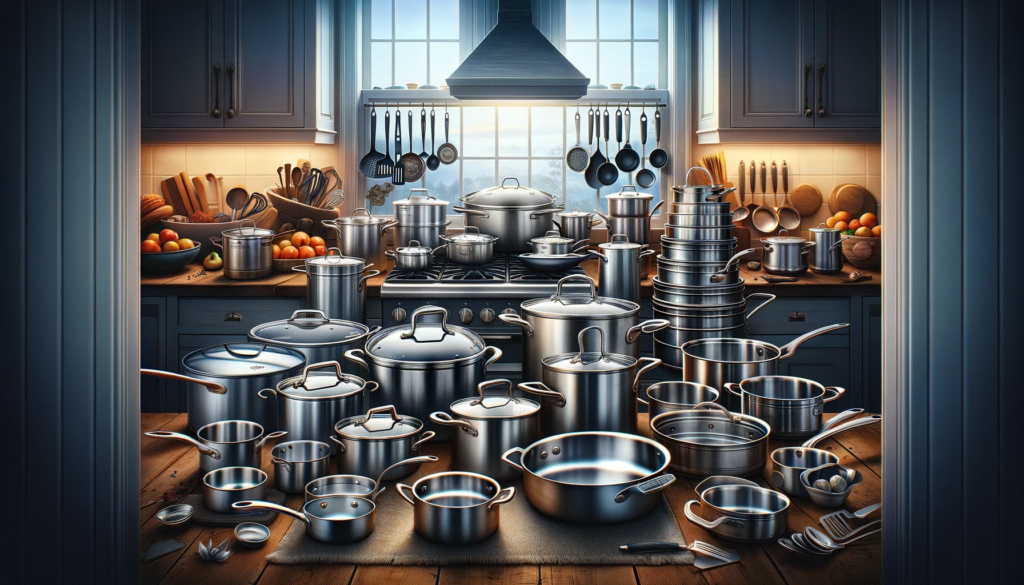
While prolonged metal utensil usage risks gradually damaging stainless steel over an elongated timeframe, individuals not interested in purchasing alternative utensils can still take preventative steps to minimize scratches through proper usage habits.
Refrain from cutting directly in stainless steel pans using sharp knives or shears whenever possible.
Use separate cutting boards instead.
When cooking in pans, stirring should involve controlled wrist motions rather than aggressively scraping across the base metal on metal.
Similarly, flipping thinner proteins like eggs or pancakes requires lightly sliding spatulas under rather than gouging forcefully against cookware.
Immediately replace old metal utensils showing significant wear along bottom edges and tips contacting pan surfaces during usage.
Any visible rugged burrs or gaps raise scratching dangers.
Seeking out stainless steel, silver or smoother copper composition alternative metal utensils instead of very hard uncoated alloys like cast iron reduces scratch probability as well.
Always wash stainless steel gently by hand or dishwasher using non-abrasive soft scouring pads instead of metal wool or excessively gritty scrub sponges producing added friction that degrades surfaces.
Occasionally apply protective metal polish paste to resurface the very top micro layer of stainless steel containing any fine scratches potentially sustained over time with the gentlest motions possible.
Read more here.
For preventing incidental damage during storage, use pan protectors like felt pads or cloth liners before stacking other pots inside a larger one.
Provide some barrier between the stainless steel surfaces.
Wrap lids in linen kitchen towels or slip on cap protectors.
Safely arranging cookware apart on racks or lying separately in drawers guards against accidental collisions generating scratches while avoiding moisture contact leading to corrosion issues mentioned.
Careful usage habits combined with addressing scratches early through metal polish reduces risks.
But transitioning to wood, silicone or plastic utensils eliminates metal dangers entirely.
Conclusion
In conclusion, while stainless steel cookware is designed to be durable, the prolonged use of metal utensils can still gradually damage the surface leading to scratches and corrosion over time.
To protect cookware investments and maintain optimal cooking performance, it is best to use alternative utensils made of wood, silicone, plastic, or bamboo instead of metal.
But for those who still prefer metal, steps like avoiding scrubs, replacing worn utensils, and addressing minor scratches early can help minimize risks.
